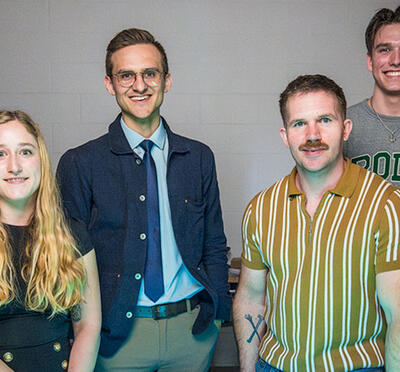In a way, Sanjida Yeasmin is pursuing her PhD in electrical and computer engineering not just for herself, but for countless others as well.
“I’m trying to bring electronics to the medical field to save lives or make lives better. This always drives me,” she said.
Yeasmin’s current research centers on biosensors, analytical devices that noninvasively detect biomolecules and other chemicals in the body to measure aspects of health. Her interest in biosensors started five years ago when she was studying for her master’s degree at the Hong Kong University of Science and Technology.
“I developed a sensor which can detect a biomarker in the human body related to heart attacks. When someone has a heart attack, the marker is released inside their body in the early stage, so we can know how they are affected,” Yeasmin explained.
After earning her master’s degree in 2017, Yeasmin, who is from Bangladesh, prepared for her next international move: joining the research staff at Nanyang Technological University in Singapore. There, she developed colorimetric paper strips that change color when exposed, in bodily fluids, to specific markers associated with lung cancer.
“My master’s thesis and my research experience in Singapore motivated me to pursue my main goal of bringing laboratory-based diagnostics to rapid onsite, at-home testing,” Yeasmin said.
For this undertaking, Yeasmin set her sights westward for Ph.D. programs.
Although accepted by multiple universities, Yeasmin quickly gravitated to Oregon State. One reason is the Outstanding Scholars Program, which offers two-year stipends and professional development opportunities to adept computer science and electrical and computer engineering graduate students whose work will positively impact the future. From 2019-21, Yeasmin was one of 12 students in the inaugural Outstanding Scholars cohort.
Further, Yeasmin chose Oregon State because her research interests align with those of Larry Cheng, associate professor of electrical and computer engineering, who is now her project advisor. Together, they are developing two types of sensors; the first is an electrochemical sensor that detects cortisol, a hormone correlated to stress, in the body.
“We are making a wearable sensor which can be attached to your skin. When cortisol is released in your sweat, the sensor will detect it and give you a signal in your phone,” Yeasmin said.
This at-home diagnostic approach has several advantages. It saves time and promotes accessibility, because the test does not need to be sent to a lab, which could take weeks. It is also less expensive, because, unlike other commercial sensors, it does not require enzyme analysis.
“We are trying to make an enzyme mimetic material to replace the enzyme to reduce the cost,” Yeasmin said. “We want to make it robust, something which can be used at home simply, like pregnancy sticks.”
The second sensor Yeasmin and Cheng are developing involves light-emitting carbon dots, which could have applications in bioimaging, disease detection, hormone level analysis, and other aspects of human health.
“These are very small, nanometer-range particles, which can emit red, orange, green, blue — every color, really. We are working on that to use in biosensors and also for micro-LED displays,” Yeasmin said.
Most LED technology relies on quantum dots, but these nanoparticles present environmental hazards because they contain heavy metals, such as cadmium. The European Union banned cadmium and other harmful substances in its 2011 Restriction of Hazardous Substances directive for electronics. Cheng and Yeasmin have developed an alternative.
“The new material is primarily made of carbon — no metal. We are making an eco-friendly product with good light-emitting properties and a very high quantum yield,” Yeasmin said.
Cheng and Yeasmin’s carbon dot project has received support, via the Accelerator Innovation and Development fund, from Oregon State’s Advantage Accelerator. The program funds innovative, tech-based projects, aiding researchers from conceptualization through commercialization. Its support perfectly reflects Yeasmin’s own desire to be an entrepreneur upon graduating.
“We are doing something that can solve existing problems and have the potential to go to market immediately. That’s the thing that always drives me,” Yeasmin said. “Starting from material synthesis, device fabrication and sensing — everything is conducted in the Cheng research lab. We’re developing sensors that can rapidly and precisely assess health conditions, thereby reducing health risks and avoiding hospital visits. This is the beginning of a new adventure for me, and I’m looking forward to it.”



